Paddington, Middlesex, London
Up to 1834
A parliamentary report of 1777 recorded a parish workhouse in operation at Paddington with accommodation for up to 12 inmates.
After 1834
Between 1837 and 1845, Paddington formed part of the Kensington Poor Law Union. During this period, paupers were housed in a number of former parish workhouses: males in a workhouse at Kensington, women at Chelsea, boys at Hammersmith, and girls at Fulham. In 1845, the Kensington Union was dissolved with Fulham and Hammersmith forming a new Fulham Union. Kensington and Paddington then began operating as independent Poor Law Parishes.
A new Paddington workhouse was erected in 1845-6 at a site to the south of the Harrow Road, on the north bank of the Grand Union Canal. Females were accoimmodated at the west of the site and males at the east. The sick wards were extended in 1867-8 together with the addition of a dispensary and new relief offices.
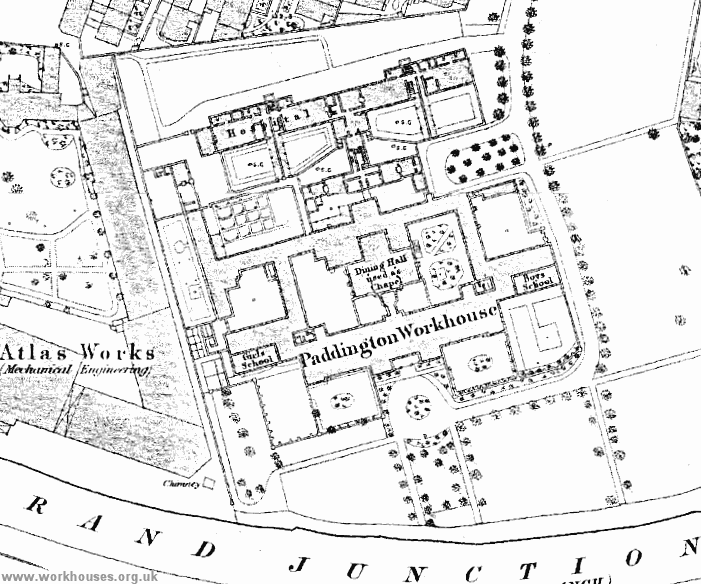
Paddington workhouse site, c.1870.
Further extensions were added in 1874, and in 1886 a new infirmary block was erected to the east, between the workhouse and the adjacent Lock Hospital.
Paddington workhouse site, c.1896.
The new infirmary had four floors plus 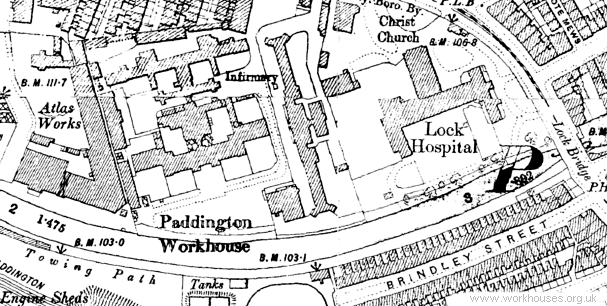 a basement, with male patients accommodated to the south, and females to the north. Distinctively shaped sanitary towers (conatining lavatories etc.) protruded at each end.
a basement, with male patients accommodated to the south, and females to the north. Distinctively shaped sanitary towers (conatining lavatories etc.) protruded at each end.
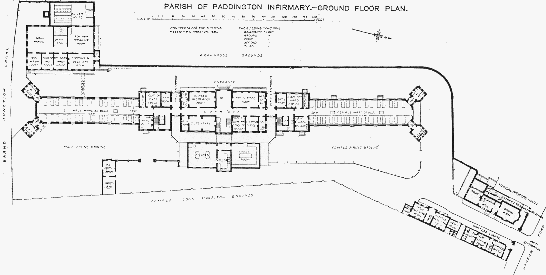
Paddington Infirmary, 1886. (Click on picture for enlargement)
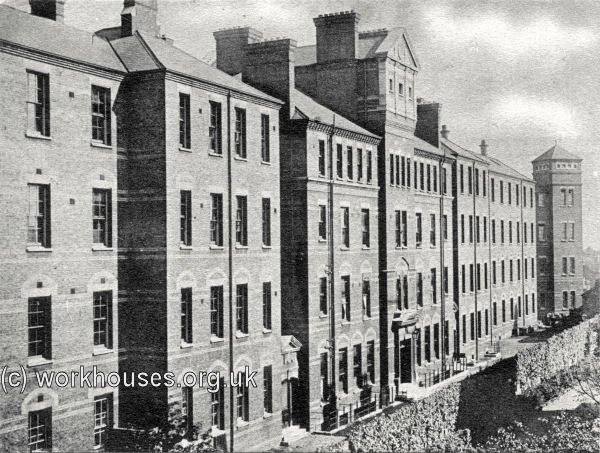
Paddington Workhouse Infirmary from the north-west, c.1906.
© Peter Higginbotham
One of the labour tasks provided for able-bodied inmates at Paddington was stone breaking. For this purpose, there was a row of cells, each having a grated opening to the outside. Large lumps of stone had to be broken up into pieces small enough to be fed through to the outside.
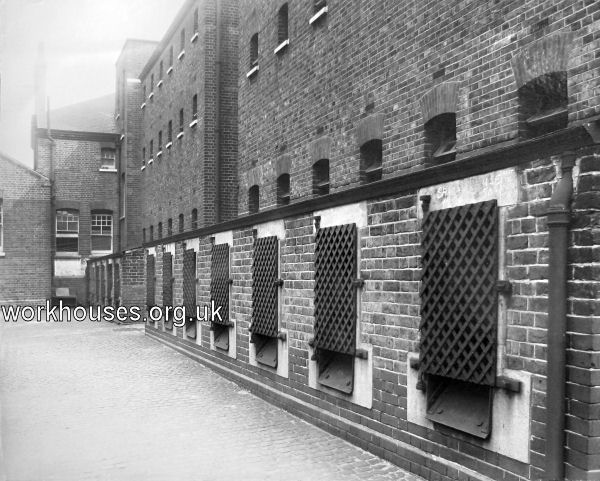
Paddington Workhouse exterior of stone-breaking cells.
In 1914, all the inmates were transferred to the Marylebone workhouse and the Paddington site was taken over for use as a military hospital which specialised in the care of limbless men.
After the war, the institution adopted an increasingly medical orientation, with its overall management being placed under its medical superintendent. In 1921, it adopted the name Paddington Hospital and a nurses' home was opened in the same year. Links were also developed with St Mary's Hospital, Paddington.
In 1930, the workhouse and infirmary came under the control of the London County Council. It became Paddington General Hospital in 1954, then from 1968 was the Harrow Road branch of St Mary's Hospital. It was closed in 1986 and the buildings have since been demolished. Elmfield Way now occupies the site.
Receiving Home
By the early 1900s, the Paddington Guardians were operating a Receiving Home for up to 35 children at Trenmar House, 12 Trenmar Gardens, Kensal Green. The home dealt with children newly entering the care of the Union. Paddington appears not to have run any other children's homes itself. However, the union was a member of the West London School District with some of its children being sent to the District School at Ashford.
Staff
Inmates
Records
Note: many repositories impose a closure period of up to 100 years for records identifying individuals. Before travelling a long distance, always check that the records you want to consult will be available.
-
The
Ancestry UK
website has two collections of London workhouse records (both name searchable):
- Westminster workhouse records are available on FindMyPast, .
-
London Metropolitan Archives, 40 Northampton Road, London EC1R OHB.
Holdings include:
- Harrow Road Workhouse — Admissions and discharges (1883-97); Births (1900-1914); Guardians' minute books (1845-1930); Financial records (1845-1930); Staff records (1845-1930); etc.
- Receiving Home, Trenmar Gardens — admission and discharge registers (1910-24, 1931-36); Creed registers (1910-36).
Bibliography
- None.
Links
- None.
Unless otherwise indicated, this page () is copyright Peter Higginbotham. Contents may not be reproduced without permission.


